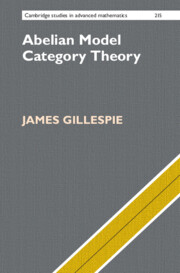Book contents
- Frontmatter
- Dedication
- Contents
- Preface
- Introduction and Main Examples
- 1 Additive and Exact Categories
- 2 Cotorsion Pairs
- 3 Stable Categories from Cotorsion Pairs
- 4 Hovey Triples and Abelian Model Structures
- 5 The Homotopy Category of an Abelian Model Structure
- 6 The Triangulated Homotopy Category
- 7 Derived Functors and Abelian Monoidal Model Structures
- 8 Hereditary Model Structures
- 9 Constructing Complete Cotorsion Pairs
- 10 Abelian Model Structures on Chain Complexes
- 11 Mixed Model Structures and Examples
- 12 Cofibrant Generation and Well-Generated Homotopy Categories
- Appendix A Hovey’s Correspondence for General Exact Categories
- Appendix B Right and Left Homotopy Relations
- Appendix C Bibliographical Notes
- References
- Index
8 - Hereditary Model Structures
Published online by Cambridge University Press: 19 December 2024
- Frontmatter
- Dedication
- Contents
- Preface
- Introduction and Main Examples
- 1 Additive and Exact Categories
- 2 Cotorsion Pairs
- 3 Stable Categories from Cotorsion Pairs
- 4 Hovey Triples and Abelian Model Structures
- 5 The Homotopy Category of an Abelian Model Structure
- 6 The Triangulated Homotopy Category
- 7 Derived Functors and Abelian Monoidal Model Structures
- 8 Hereditary Model Structures
- 9 Constructing Complete Cotorsion Pairs
- 10 Abelian Model Structures on Chain Complexes
- 11 Mixed Model Structures and Examples
- 12 Cofibrant Generation and Well-Generated Homotopy Categories
- Appendix A Hovey’s Correspondence for General Exact Categories
- Appendix B Right and Left Homotopy Relations
- Appendix C Bibliographical Notes
- References
- Index
Summary
This chapter defines and studies hereditary model structures and their homotopy categories. This includes the special case of projective and injective model structures. It is shown that the homotopy category of any hereditary model structure is equivalent to the stable category of a Frobenius category. Morphism sets in the homotopy category are characterized as Ext groups. Practical methods for constructing hereditary model structures are also given. The end of the chapter focuses on adjunctions and recollements between homotopy categories as well as conditions guaranteeing that the homotopy category of an hereditary model structure is compactly generated.
Keywords
- Type
- Chapter
- Information
- Abelian Model Category Theory , pp. 208 - 254Publisher: Cambridge University PressPrint publication year: 2025

